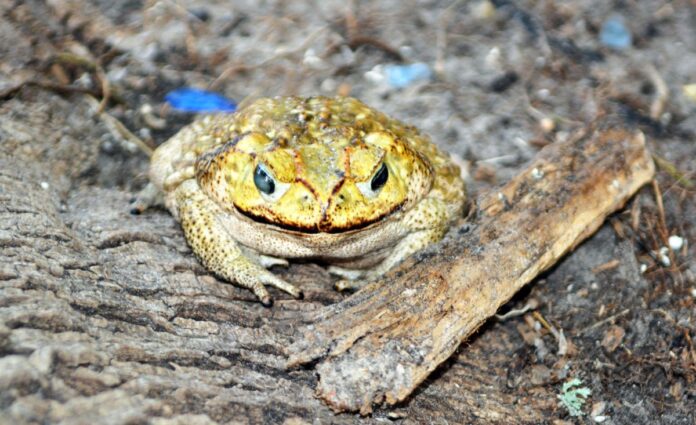HARLINGEN — They are gargantuan, surprisingly quick, voracious, poisonous and in your backyard.
Giant cane toads aren’t likely to cause humans any problems, bar the occasional heart attack when you nearly step on a two-pounder in the dark.
But the toxins cane toads produce can be deadly to your dog or cat.
Cane toads, known to biologists by their Latin name, Rhinella marina, have earned a distinctly poor reputation elsewhere in the world.
In Florida, where they were introduced to combat sugar cane beetles, they are a significant pest.
In Australia, where they also were introduced in 1935 to combat the greyback cane beetle, they are described in terms such as “crisis,” “super-invader” and “runaway evolutionary effect” as they swarm across the continent.
Here in the Rio Grande Valley, we know them as natives.
“They really don’t pose any threat to humans unless you’re picking them up and licking them — it’s called toad-licking — for the mild hallucinogenic effect,” said Dr. Shawn Varney, medical director at the South Texas Poison Center in San Antonio.
But pets, dogs in particular, have suffered mortality due to licking or chewing on the cane toad, Varney said.
For the rest of this story and many other EXTRAS, go to our premium site, www.MyValleyStar.com.
Subscribe to it for only $6.99 per month or purchase a print subscription and receive the online version free, which includes an electronic version of the full newspaper and extra photo galleries, links and other information you can’t find anywhere else.
When threatened or handled, the cane toad secretes a highly toxic milky substance from its large parotid glands at the back of its head, behind the ears. This secretion can burn your eyes, may irritate your skin, and can kill cats and dogs if they ingest the secretion.
Symptoms in pets
Drooling, head-shaking, crying, loss of coordination, and, in more serious cases, convulsions. The dog’s (or cat’s) gums often turn red, an indicator used by veterinarians to distinguish toad poisoning from epilepsy. For this reason, pet owners should be familiar with their pet’s normal gum color.
Treatment
If you suspect toad poisoning, get a hose and run water in the side of the dog’s/cat’s mouth, pointing the animal’s head downward so water isn’t swallowed. Rub the gums and mouth to remove the toxin. This treatment is usually successful, but call your veterinarian immediately.
Source: University of Florida
Scientific name: Rhinella marina; formerly Bufo marinus
Common names: Cane toad, giant toad, marine toad, giant marine toad, South American cane toad, Dominican toad, spring chicken (Belize)
Length: Adults average 3.9 inches to 5.9 inches; record 9.4 inches
Weight: Up to 2.9 pounds
Native To: South America, Central America, Mexico and extreme South Texas
Introduction elsewhere: Florida, Caribbean, Philippines; regarded as major pest in Australia
Means of Introduction: Originally introduced to control sugar cane pest, the greyback cane beetle; also accidentally and intentionally released by animal importers, zoos and laboratories
Diet: Mostly nocturnal. In addition to the normal prey of small rodents, reptiles, other amphibians, birds, bats and a range of invertebrates, they also eat plants, dog food and household garbage
Impact: Highly toxic to predators (including pets)
Source: U.S. Department of Agriculture
If you have questions about cane toad poison, or any other poison, Varney says to call the South Texas Poison Center at 800-222-1222.




